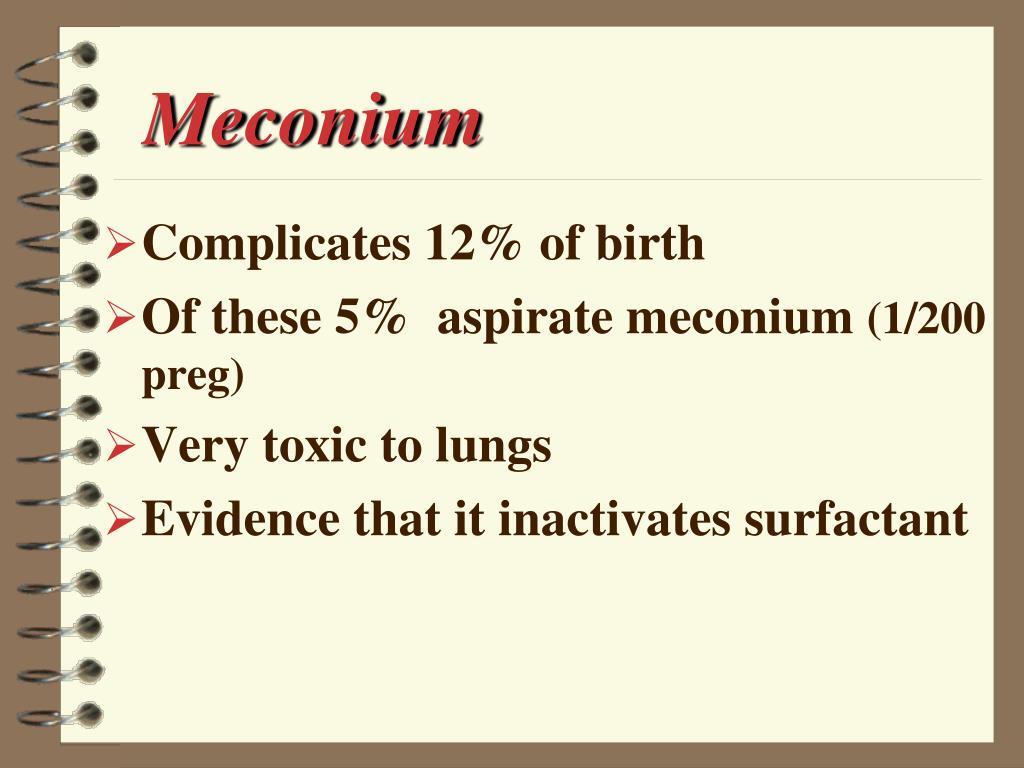

The thicker the meconium, the worse the associated morbidity and mortality due to the fact that thicker secretions simply muck up the works worse than thin, dilute secretions can. placental compromise due to smoking, hypertension, or substance abuse.fetal distress during labor and delivery,.Risk factors for meconium-stained amniotic fluid include increased risk of pulmonary hypertension.increased risk of aspiration pneumonia,.high mortality rate, an increased risk of hypoxemia,.In other words, morbidity/mortality may be associated with the "fetal distress" associated with meconium, but it is the event(s) prior to birth that set the baby up for fetal distress when challenged against a limited fetal ability to withstand.įor all of the reasons above and because of all of the attributes meconium-stained amniotic fluid has, it is a phenomenon that carries with it a The events may even possibly have been set in motion before labor! Most feel that the morbidity/mortality associated with meconium is not so much due to events at birth ("fetal distress") but are a result of limited fetal reserve to tolerate challenges during birth, such as contractions with intermittent hypoxia-that is, events prior to birth that limit a baby's ability to tolerate stress-events which could not have been controlled and are probably long over before labor and delivery even began. In SGA babies, there usually has been compromise of the placenta that has negatively impacted its ability to oxygenate and provide adequate nutrition for adequate growth.īoth cases result in compromised infants that may lack adequate "reserve" to withstand the normal rigors of labor and delivery, creating hypoxia and with it, the mechanical breathing reflexes that result in the expulsion of meconium into the amniotic fluid.

In post-term infants, the baby keeps growing (requiring more) but the placenta starts deteriorating (providing less), and these respective, opposing phenomena can clash.(Meconium AT THE TIME OF BIRTH is normal-merely a squeezing out of the intestines through the anus with the compression/decompression forces of delivery.) Meconium-stained amniotic fluid occurs " in utero" (inside the womb before delivery) and is mostly found in post-term and small-for-gestational-age (SGA) newborns.

Meconium is a sign of fetal distress, either on-going or old. This results in hypoxia, hypercapnia (elevated CO2), and acidosis (blood pH < 7). Patient deterioration can occur due to meconium stained amniotic fluid that is aspirated into the fetal lungs before birth. Incomplete airway obstructions include "ball-valve" type obstructions, pneumothorax, and chemical irritation pneumonia. Complete airway obstructions include atelectasis and a right-to-left shunt across the foramen ovale due to the increased pulmonary pressure that atelectasis creates in the pulmonary vasculature. It can result in complete or incomplete airway obstructions. Meconium is very inflammatory and irritating to the fetal lungs and can result in neonatal meconium pneumonitis, which has significant morbidity and mortality in the nursery. The likelihood of this complication depends on the gestational age at delivery:

Although the staining itself is harmless, it is a sign of something that can prove very dangerous if the fetus were to aspirate the meconium-stained amniotic fluid (→ causes Meconium Aspiration Syndrome (MAS) after delivery, a severe life-threatening pneumonitis). Meconium is made up of vernix, lanugo (fine hair), desquamated epithelial cells, and other intestinal contents (bile, mucus, etc.), and it can cause a harmless " meconium staining" of the fetal skin-often a greenish hue. Meconium-stained amniotic fluid is often caused by fetal hypoxia or other physiologic stress.Īny reflexive "gasping" of the unborn fetus, due to hypoxia, can depress the fetal diaphragm mechanically, squeezing the contents of the bowels into the amniotic fluid.


 0 kommentar(er)
0 kommentar(er)
